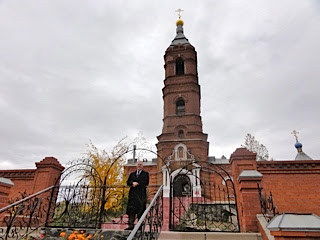On Thursday, I had the opportunity to go on a city tour of Orsk with students from the Institute. It was organized by Professor Yelena (Helen in English) Leontyeva, an English teacher/teacher trainer at the Institute. This is what I learned.
 |
| The Ural River divides Orsk between two continents: Asia the left, and Europe on the right. |
Because of its isolated location (on the border of Asia and Europe, and on the border of what is today Kazakstan), far from any major population centers, it was a favorite location of both the Russian Czars and of Stalin to exile dissidents and intellectuals. This contributed greatly to the cultural foundations of Orsk. Some of the intellectuals who were exiled here created a school that was the predecessor of the Institute where I am guest teaching. The city is also the home of some famous poets.
 |
| With the students in front of a culture center in the newer part of the city. The city name, Orsk, is OPCK in Russian. |
The newer part of the city, on the European side of the river began during World War II when several factories were moved to Orsk from the large cities of Russia to escape the threat of bombings. Housing was constructed for the workers and the industrial side of Orsk developed. The city today has a population of slightly more than 250,000 inhabitants.
The original church fell into disrepair during the Soviet period, when many churches in Russian were closed and/or destroyed. Since that time, the church has been beautifully restored and expanded with new buildings and ornate towers added to the complex.
 |
| The main tower of the church, is the oldest structure in Orsk built in 1735 and reconstructed in 1894 |
 |
| The newest church in Orsk, nearing completion on the European side of the city. |
 |
| The eternal flame at the World War II memorial. Tablets with the names of the fallen in the far rear. Click here to see more photos. |
 |
| The world famous red star symbol at the entrance to the memorial. |
Nice pictures!!! You should go swimming in that river
ReplyDelete